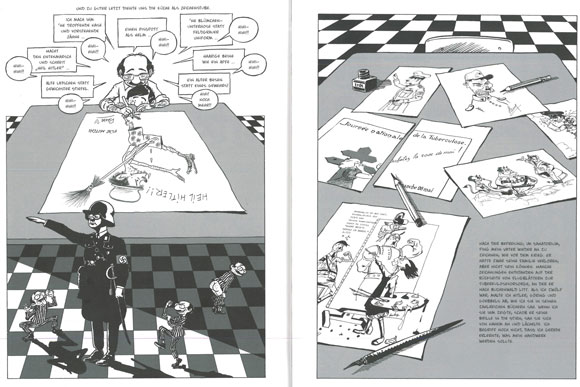
German students at Duke are using graphic novels like these to learn about German history.
For six undergraduates, comic books are an exceptional way to delve into academic discussions of contentious historical and cultural issues.
Under the instruction of German professor Corinne Kahnke, students in GER 338S: “German Graphic Novels” have examined the most significant episodes in German history -- from Nazism to the fall of the Berlin Wall --through the panels of graphic novels. The students then used their knowledge of the history of this non-traditional literary medium to create an exhibit on the second floor of Bostock Library, near the East Asian Reading Room.
The exhibit, called “An Illustrated Perspective: Analyzing German History through the Graphic Novel Medium,” opened March 17 and will remain on display through the end of the semester.
Kahnke, who is teaching the course for the first time this semester, said it helps students learn more about reading and producing works in an unconventional genre while also examining the historical events in Germany.
“The first graphic novel to really catch the eye of literary critics was ‘Maus’ [by Art Spiegelman, the son of a Holocaust survivor],” Kahnke said. “German history played an important role in bringing this genre to prominence. Since then, not only have graphic novels become more and more popular, but they have dared to examine more complex social and political issues, from GLBTQ rights to multiculturalism in Germany.”
Kahnke added, “I not only wanted my students to trace the trajectory of the German graphic novel but to also think critically about how a non-traditional form of literature can help us think differently about well-known [episodes] in history.”
For the exhibit, each student selected his or her favorite scene and analyzed it in both English and German. The exhibit includes a brief history of the graphic novel in German literature and students’ original comic panels, which were scenes from the everyday lives of Duke students.
Sophomore Morgan Daly said the most challenging aspect of creating the exhibit was covering all of the themes that interested the students.
“Graphic novels have so many varying elements that it’s very difficult for an outsider to understand the novel from just one scene,” Daly said. “The novels we have read cover such a range of topics that it was difficult selecting exactly what the theme of our display would be.”
Senior Elizabeth Nadler said that after finalizing the pieces to be included in the exhibit, she and her classmates also faced the challenge of making German history and culture accessible to American readers in a limited space.
“I was nervous about translating German texts for an American audience,” Nadler said. “Though the words were easily translated, the historical significance was harder to convey. Americans don't fully understand the hardships of the GDR or the tensions in modern German-Turkish relations.”
Despite the academic and practical challenges associated with creating an exhibit, senior Jeremy Clift said the process exposed him to a new medium of storytelling and made him a better storyteller.
“Preparing an exhibit challenges one to consider the best way to both effectively and efficiently convey your [story] to an audience,” Clift said. “And the class [as a whole] has really heightened my awareness of the techniques used in graphic novels to portray themes in unique ways.”
Senior Benjamin Spilsbury said he hopes that he and his classmates have successfully relayed graphic novels’ significant contributions to German literature and that the exhibit will prompt other members of the Duke community to experience graphic novels for themselves.
“With graphic novels, there is much more than meets the eye,” Spilsbury said. “Many people think that whatever can be done in a graphic novel can probably be done better in a book or on the silver screen. But [by combining image and text], graphic novels offer such a different perspective than other media.”
For more information on German Department events, visit their website.